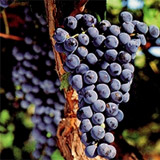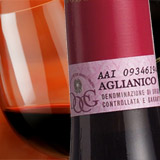Aglianico is a black grape grown in the Basilicata and Campania regions of Italy. The vine is believed to have first been cultivated in Greece by the Phocaeans from an ancestral vine that ampelographers have not yet identified. From Greece it was brought to Italy in the 6th century B.C. by settlers to Cumae near modern-day Pozzuoli, and from there spread to other areas in Italy.
In ancient Rome, the grape was the key element of the world's earliest first-growth wine, Falernian. Aglianico was commented on by Pliny the Elder, the maker of some of the highest-rated wines in Roman times. The grape was called Ellenico - the Italian word for Greek - until the 15th century when it acquired its current name Aglianico. The thoroughly modern tool of DNA analysis has found no close relationships with any known Greek varieties.
In Basilicata, Aglianico forms the basis for the region's only DOCG wine, Aglianico del Vulture, and is concentrated around the areas of Matera and Potenza. The most sought-after wines of Aglianico del Vulture come from the vineyards located around the dormant volcano Mount Vulture. In Campania, the area near the village of Taurasi produces Aglianico's only DOCG wine, also called Taurasi. In Campania, it is also the principal grape of Aglianico del Taburno and Falerno del Massico.
The Aglianico vine buds early and grows best in dry climates with generous amounts of sunshine and seems to thrive in particularly volcanic soils. The grape has a tendency to ripen late, with harvests as late as November in some parts of southern Italy.
Aglianico wines tend to be inky-black depths of colour, full-bodied with firm tannins, firm structure and high acidity, endowing them with good aging potential. The rich flavours of the wine make it appropriate for pairing with rich meat dishes. As it ages, the fruit becomes more pronounced and the tannins balanced with the rest of the wine. Aromas and flavours of black fruits, smoke, dark chocolate and mineral.










